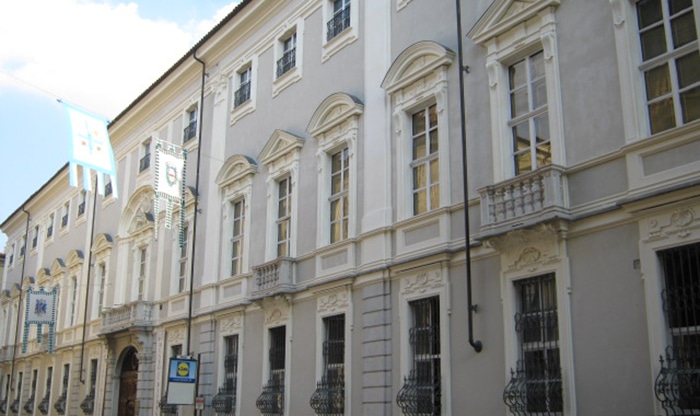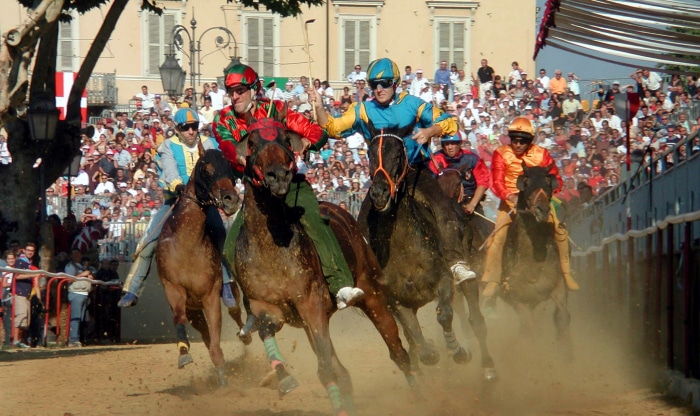The city of Asti, with a population of 77,000, is known throughout the world for the hills surrounding it and for its enogastronomy but little for its artistic heritage, rich in Romanesque and medieval testimonies.
Towers, churches, historical buildings, museums, squares: Asti is a city to discover slowly, strolling through the alleyways and the elegant shops.

Cathedral
Built between the last years of the ‘200s and the first half of the 300s on a pre-existing building (of which remains a paving mosaic visible in the presbytery), it is the most beautiful and impressive example of Gothic in Piedmont. It enhances the view from the south side with the splendid Romanesque bell tower. Inside there are many masterpieces and frescoes.

Collegiate San Secondo
Dedicated to the patron saint of the city, the present church was built between the 13th and 15th centuries. From the former building remains the Romanesque bell tower and the central part of the crypt. The three-nave gothic interior features valuable works while the first chapel of the right nave houses Palio’s drapes donated to the Collegiate each year during the medieval Palio’s ceremony on the 1st Tuesday of May.

Palazzo Alfieri – Alfierano Museum Guglielmetti Foundation
Here was born the great astesan writer Vittorio Alfieri, on 1749, January the 16th. The palace was “modernized” around 1736 by the architect Benedetto Alfieri (Vittorio’s cousin). The noble floor includes the apartments and the birth room of Vittorio Alfieri. The palace houses the Fondazione Centro Studi Alfieriani and the Alfierian Museum.

Museo San Anastasio Asti
Archaeological site and museum site, it houses the remains of four churches (from the eighth to the seventeenth century) belonging to the Benedictine monastery of Sant’Anastasio and the splendid Romanesque crypt. In the museum are exposed the sandstone capitals of the second Romanesque church of S. Anastasio (beginning of the 12th century), capitals, shelves, sculpted archons (13th-15th century) coming from the disappeared Gothic church of Maddalena.

Mazzetti Palace Asti
Transformed by Benedetto Alfieri, it has sumptuous interiors on the noble floor and today it is home to the Civic Art Gallery, which houses, among others, the tables of the master of San Martino Alfieri (XVXVI sec.), works by Guglielmo Caccia, by Giancarlo Aliberti, Genoese painters of the sixteenth century with two canvases of Valerio Castello, the wooden microsculptures of G.M. Bonzanigo and a rich collection of Piedmontese and Italian artists of the 1800s and 1900s (among them Grosso, Delleani, Pittatore, Cagli, Guttuso).

Ottolenghi Palace – the Risorgimento Museum
The museum features memorabilia, pictorial works, flags, weapons and coins from the period 1797-1870, the result of donations of astigian families. From the rooms, equipped with multimedia devices, you go down to the World War II anti-aircraft shelter where a touching projection traces the astesan events of the period.

Alfieri theater
Opened in 1860, it has a horseshoe construction with four stages orders for a total of 103 plus the loggia. The total capacity was 2000 people. After long restoration works, the theater has returned to splendor for some years and hosts a prestigious season and a contemporary dramaturgy festival.

Events in Asti
- FESTIVALS OF SAN SECONDO Old Town – 1st Tuesday of May
- PALIO Piazza Alfieri – 3rd Sunday of September
- SAGRE FESTIVAL Piazza Campo del Palio – 2nd Week of September
- DOUJA D’OR Enofila – Corso F. Cavallotti 45 – From the 2nd weekend to the 3rd Sunday of September
- REGIONAL FAIR OF TARTUFO Piazza San Secondo – 3rd Sunday of November

Asti surroundings
A cluster of land, between the beautiful UNESCO hills of the Monferrato and the Langhe. Villages, castles, demonstrations and traditions make the Asti area a lively land, animated by the many small towns scattered among the rows of vineyards.
Places to discover slowly, by foot, by bicycle, alternating outdoor hiking, cultural visits between museums, castles and towers, stops in the cellars, pleasant sports activities, wellness treatments and shopping, then ending the day in one of the many delicious restaurants where you can taste the dishes of the rich gastronomic heritage.
Start your visit from Villa Fiorita and download the guide to the territory by clicking here







